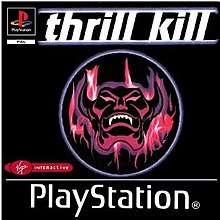Thrill Kill
Thrill Kill is an unreleased 1998 fighting video game for the Sony PlayStation. While the technical feat of allowing four players to fight simultaneously in the same room was to be a major selling point, this was overshadowed by the controversy surrounding the game's depictions of violence and sexual content. Examples of this content include BDSM and fetishistic costumes and acts, limb dismemberment, and violent special moves with suggestive names such as "Bitch Slap" "Swallow This" and "Going Down". Thrill Kill notably received the rare "Adults Only" (AO) rating from the Entertainment Software Rating Board, and was the first game to receive such a rating for its violent content; all prior AO ratings had been for sexual content. Owing to this, Thrill Kill was ultimately not released; near-finished builds of the game, however, were later bootlegged and uploaded to the Internet.
| Thrill Kill | |
|---|---|
 | |
| Developer(s) | Paradox Development |
| Publisher(s) | Virgin Interactive |
| Platform(s) | PlayStation |
| Release | Cancelled (intended for mid-1998) |
| Genre(s) | Fighting |
| Mode(s) | Single-player, multiplayer |
History
Thrill Kill was developed in the late 1990s for the Sony PlayStation by Paradox Development, later Midway Studios - Los Angeles. There was much hype surrounding the game, billed as the new Mortal Kombat, and expectations were high in the gaming community. The publisher was to be Virgin Interactive, but in the summer of 1998 the North American operations of Virgin Interactive were acquired by Electronic Arts as part of their buyout of the developer Westwood Studios, whom Virgin Interactive also owned. This led to EA buying the publishing rights to the game.
By this point Thrill Kill had already finished development in entirety. A few weeks before shipping, the game's release was scrapped by Electronic Arts because they didn't want to "publish such a senselessly violent game", as they felt that it would harm their image. They also stated that they deemed the game so offensive that they would not even attempt to sell the game nor to have it released by another publisher.
Later, former employees that had worked on the game released the full game to the group T@STY who completed it before releasing it onto the internet along with various beta versions and bootlegs of the game. These flooded the market and were still seen by a large share of its original intended audience nevertheless. All files are still widely available through filesharing, and playable through emulators.
Gameplay
Gameplay consisted of a closed 3D room where up to four opponents would fight to the death, and proceed to finish each other off with Thrill Kills, much like the fatalities of Mortal Kombat. Every attack made would result in a character's bloodlust rising. Instead of the usual life bar, characters built up a "kill meter". Once this meter was full, and therefore bloodlust at its strongest, a player's character would be electrocuted to give them superhuman strength enabling a Thrill Kill move to brutally slay an opponent, depending on what button was pressed upon grabbing someone.
Plot
Ten damned souls have died and descended into Hell. This modern-day Hell is based on the real world of today's deviants. The characters are the physical manifestations of their mental illnesses or the evil hidden within their mortal selves. Each character has been a murderer, usually after their said illness/evil inner self. Marukka, the Goddess of Secrets, is bored of her usual routine and decides that it would be entertaining to pit all of the characters against one another in a fighting tournament with the prize being reincarnation. Each character is battling for nothing more than self-preservation and the hope of being reborn.
Development and cancellation
The controversy surrounding the game raised the interest of Thrill Kill in the gaming community greatly, helping bootleg copies of the game to become very common. In their September 2004 issue, Official U.S. PlayStation Magazine cited Thrill Kill as one of the most overrated cancelled games, stating "It got lots of hype. But it really sucked, too."[1]
The Thrill Kill engine was later used in numerous other games. It was used to make Wu-Tang: Shaolin Style (released on October 31, 1999 by Activision), a game based on the rap group Wu-Tang Clan. The Thrill Kill engine was later used in two-player form for X-Men: Mutant Academy (released on July 11, 2000 by Activision), X-Men: Mutant Academy 2 (released on September 17, 2001 by Activision) and Rock 'Em Sock 'Em Robots Arena (released on November 30, 2000 by Mattel Interactive).[2]
In 2009, Game Informer ranked Thrill Kill tenth on a list of "The Top Ten Games That Almost Were".[3] In 2011, GamePro ranked The Imp fourteenth on a list of "The 50 Best Fighting Game Characters Ever".[4]
Soundtrack
California-based industrial band, Contagion, recorded numerous songs and an entire score for the game (which later ended up on their album Infectant).
References
- OPM staff (September 2004). "Overrated/Underrated" (SWF transcript Archived December 19, 2008, at the Wayback Machine). Official U.S. PlayStation Magazine
- Rock 'em Sock 'em Robots Arena: The fourth rendition of the Thrill Kill engine brings us a cool fighter -- new screens and videos, ign.com, 9 February 2000, updated 20 May 2012
- "The Top Ten Games that Almost Were", Game Informer 200 (): 18.
- "The 50 Best Fighting Game Characters Ever" GamePro 2011/Winter.